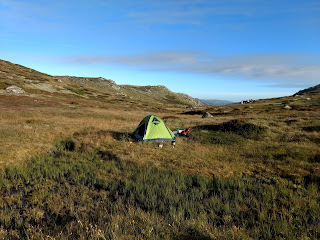What is
spin ice? What its definitive and experimental signatures?
A good place to start is the lucid discussion by Roderich Moessner and Art Ramirez in a 2006 article on
Geometrical Frustration. They emphasise two organising principles:
local constraints on neigbouring spins and the
emergence of new entities such as gauge fields.
First, let's discuss the "ice" bit since this involves some beautiful chemistry, physics, statistical mechanics, and history. In the solid phase of water at atmospheric pressure (
ice Ih) the water molecules form a hexagonal lattice, with the oxygen atoms located a the vertices of the lattice. The molecules interact with one another via hydrogen bonds.
Now the
key point is that there are many different ways of orienting the water molecules (arranging the protons). The only
constraint is that one has to have two protons covalently bonded to the oxygen and two protons on next-nearest neighbour water molecules hydrogen bonded to the oxygen. This is known as the
ice rule. Suppose we assign an Ising spin variable (+1,-1)=(in, out) = (covalent, Hbond) to each "bond" on the lattice. Then the ice rule is that on each tetrahedron the sum of the four "spins" must be zero.
How much degeneracy is there?
There are 2^4= 16 possible spin states on a tetrahedron. But, only six (a fraction of 3/8) satisfy the ice rule. To see this, put +1 on site one, then one must put +1 on one of the other three sites, and -1 on the other two. This gives 6 = 2 x 3 options.
If one neglects the interaction between vertices, the thermodynamic entropy per tetrahedron (water molecule) is
S = k ln (3/2)
Historical asides.
This "residual" entropy in ice was observed experimentally by
William Giauque in the chemistry department at Berkeley in the 1930s.
Linus Pauling
explained this in 1935, even arguing it as evidence for a specific crystal structure of ice.
Pauling's picture led to the
ice-type models that are very important (from a mathematical and conceptual point of view) in classical statistical mechanics as they are exactly soluble in two dimensions.
In 1956 Phil Anderson (who else!)
noted that Pauling's problem was equivalent to that of Ising spins on a pyrochlore lattice.
It was not until four decades later than an experimental realisation was observed in a magnetic material. The
experimental data is shown below.
But there is much more to spin ice. The local constraints lead naturally to an emergent gauge field (a pseudo-magnetic field), analogues of "magnetic monopoles", and unusual spin correlations (algebraic correlations without criticality). I now discuss the latter as they can be viewed as a "smoking gun" of spin ice.
The "magnetic field" B satisfies the constraint Div B =0. As a result the spin correlations have a dipolar form, i.e. they have a distance and directional dependence similar to the magnetic field associated with a magnetic dipole. This means the spin correlations fall off algebraically. This is in contrast to conventional magnets where spin correlations decay exponentially, except at a critical point. Furthermore, if one plots or measures the static spin structure factor S(q) one finds "pinch points" occur in high symmetry planes. The figure below shows an experimental measurement for Holonium Titanate, taken from
here.





